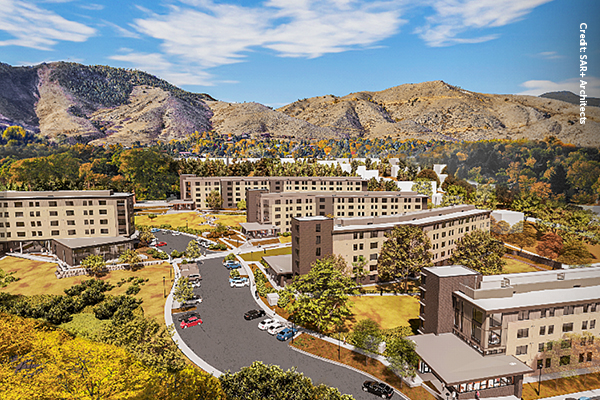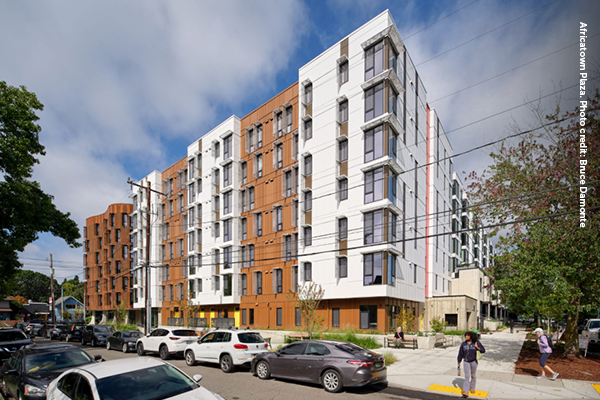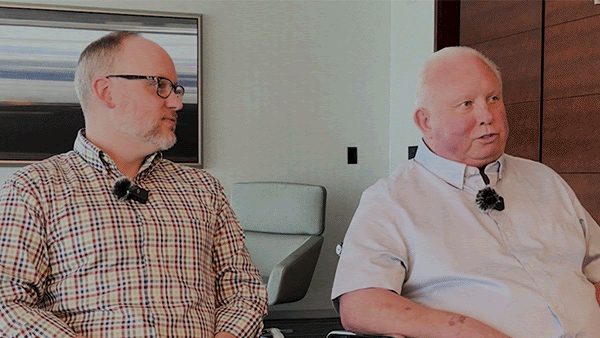HIGHLIGHTS
PROGRAM UPDATES
WoodWorks Supports Growth in Student Housing Projects Think Wood Drives Specification Through Storytelling AWC Shapes New Greenhouse Gas Standard Series SLB and Clemson Empower Faculty to Bring Timber Into the ClassroomINDUSTRY RESOUCES
Virginia Tech's Monthly Housing ReportProgram Updates
WoodWorks Supports Growth in Student Housing Projects

Student housing is one of the brighter lights in the 2025 construction forecast, with groups such as ULI and Dodge predicting a stronger year for the segment than for other submarkets. Whether teams are interested in the economy of light-frame wood, the biophilic potential of mass timber, or a combination, student housing offers significant opportunities for wood. Examples of supported projects and topics in Q2 include:
- Light-frame fire design assistance for the architect of a 350,000-square-foot 5-over-1 project in Utah.
- Light-frame structural design assistance for the architect of a 359,000-square-foot 5-over-1 building in Arkansas.
- A hybrid light-frame/mass timber design solution for a 330,000-square-foot 5-over-2 project in Texas facing a sloped site with a high-rise height limitation.
- Mass timber acoustics and fire design support for an architect designing a 200,000-square-foot project with CLT and glulam in Colorado.
- Code insights and assistance developing a mass timber-friendly massing scheme for several midrise and high-rise residential towers on a university master plan in California.
If the trend continues, 2025 could be a record year for new projects in this category, with WoodWorks potentially achieving 34 new projects representing 6 million square feet of new construction. Year to date, WoodWorks has converted 190 projects: 64% light-frame, 25% light-frame/mass timber hybrids, and 11% mass timber.
WoodWorks also leveraged student housing as a means for peer-to-peer knowledge sharing, using its speaking opportunity at the ULI Spring Meeting for a presentation by the developer of a 285-unit, 286,000-square-foot student housing project at the Colorado School of Mines. Capstone Development showed 200 developer attendees how a hybrid light-frame/mass timber structural solution can help student or multifamily housing projects with small units pencil out. Learn more about this project and its team on the WoodWorks Innovation Network.
Think Wood Drives Specification Through Storytelling

In Q2, Think Wood added 3,191 highly engaged architects, engineers, developers, and contractors to its audience—bringing the total of highly engaged professionals to 56,462. This growth was built on compelling storytelling and case studies in building segments that also represent opportunities for incremental lumber demand growth:
- Multifamily housing, both market rate and affordable (+1.2 BBF annual demand potential).
- Education (+203 MM BF demand potential).
- Commercial office (+299 MM BF demand potential).
The most engaging Q2 content remained project profiles. The two most popular stories were Africatown Plaza, an innovative light-frame affordable housing complex in Seattle, and Frame 122, one of the first mass timber multifamily buildings in New York City, with the developer planning more. Such case studies provide proof of how wood systems can be used in commercial-scale projects of all sizes, which is one of the reasons that higher engagement with Think Wood content leads to more wood use.
The increase in wood use among more-engaged users was confirmed by the results of this year’s Intent to Specify Survey, which asked users how interaction with Think Wood resources influenced their plans for wood specification. This year, 72% of highly engaged users (+11% from last year) said that interaction with Think Wood increased their likelihood of specifying. Design industry professionals that engage with more Think Wood content are more likely to specify wood, and Think Wood’s content continues to create more opportunities for deeper engagement.
AWC Shapes New Greenhouse Gas Standard Series
A recently introduced ISO standard series (ISO 13391) sets global guidance on greenhouse gas dynamics for wood and wood-based products. The standards could shape how the wood products sector measures and reports on wood product carbon. ISO 13391 covers value chain emissions, contribution to the harvested wood products pool, forest carbon balance, and potential displacement effects. The standard offers a potential alternative to the Greenhouse Gas Protocol for organizational reporting, making it a critical standard for the lumber industry.
The AWC formed and led the U.S. Technical Advisory Group (TAG) to ensure that U.S. wood products had a seat at the table during the standards’ development. Throughout the process, the AWC continued to lead the U.S. TAG through in-person and virtual meetings, consistently communicating the sustainability of U.S. forestry practices and wood products’ carbon benefits. An important win for ISO 13391 is that the standard accurately represents carbon flows for wood products and recognizes stored biogenic carbon, giving wood product manufacturers an opportunity to demonstrate their products’ carbon benefits.
In June, the AWC’s Sustainability Committee convened a meeting in Denver to work with member companies to understand how this new standard series can be used. While ISO 13391 is still a new standard, the AWC is staying engaged and continuing to support its members as they navigate implementation and consider how this standard series can affect the industry’s organizational reporting and other potential uses.
SLB and Clemson Empower Faculty to Bring Timber Into the Classroom
To expand wood’s presence in civil engineering programs, the SLB and the U.S. Endowment for Forestry and Communities partnered with Clemson University to host a two-and-a-half-day Timber Design Faculty Development Workshop in June. The workshop brought together 26 early-career faculty from 24 universities across 17 states, selected from 53 qualified applicants—underscoring a strong and growing demand for wood-focused teaching expertise.
Hosted by Clemson’s Glenn Department of Civil Engineering and the Wood Utilization + Design Institute (WU+D), the workshop paired classroom instruction with field immersion, offering turnkey teaching materials and real-world context to support new timber design courses. Led by nationally recognized instructors, the sessions emphasized the full value chain—from sustainable forestry to glulam fabrication—while equipping faculty to align courses with the National Design Specification and the 2024 IBC.
“The workshop gave me everything I need to offer this course confidently at my institution,” said Bruno Guidio, Assistant Professor at the Catholic University of America. Participants left with syllabi, project briefs, and exam templates, as well as a network of peers and wood experts for future collaboration. The program addressed not only what to teach, but also how to teach wood effectively—helping build faculty capacity for the next wave of sustainable structural innovation.
“Advancing wood design education ensures the architects and engineers entering the workforce are confident designing buildings with wood,” says Pete Madden, President and CEO of the U.S. Endowment. “The steel and concrete industries are at the table, trying to capture additional market share. It’s critical that the wood products industry is investing in education to ensure a level playing field.”
By investing in faculty development, the SLB is strengthening the pipeline of engineers prepared to design with light-frame and mass timber—ensuring wood is not only specified more often, but also specified with expertise and confidence.
Spotlight
Industry Leaders Highlight How the SLB Unites Manufacturers of All Sizes

The coming years are pivotal to the lumber industry’s efforts to increase market share and grow demand. While the industry has made major strides in codes and standards and in the market share for wood construction, continued growth is not guaranteed. Without sustained investment, hard-won progress could stall—or even slip away.
To underscore the importance of collective action, we’ll be highlighting leaders in the industry, SLB programs, and SLB partners to illustrate how and why the softwood lumber industry is working together to grow market share. This month, current and former SLB Directors Trey Hankins, CFO of Hankins, Inc., and J.D. Hankins, Co-Owner, highlight how the SLB unites manufacturers of all sizes and from each region.
“The SLB is set up really well to increase lumber demand because when we’re fighting against competing materials, you have to cast the widest net possible,” Trey Hankins said. “And the SLB is the organization that does that with all the organizations that it’s supporting, including Think Wood, WoodWorks, the AWC, and Education. It is able to fight for all sawmills regardless of location and size, and that’s the kind of breadth that we need to be able to compete effectively.”
Expect more insights from industry leaders and partners as we continue to spotlight what we’re doing to win and keep market share.
Industry Resources
Virginia Tech's Monthly Housing Report
This monthly housing commentary report is a free service of Virginia Tech and is intended to help one gauge future business activity in the U.S. housing market.
June 2025 Reports (released in August 2025)
Part A: June Housing Commentary
Part B: June Economic Conditions


